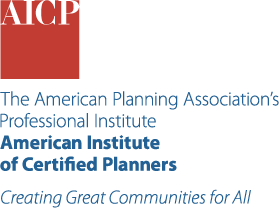Looking for education on this topic?
Check Out Our Passport Courses
Passport is your ticket to the training, experiences, and connections that will take you where you want to go in your planning career. Subscribe for unlimited access for one year to APA's extensive learning library of solution-oriented content facilitated by planners, for planners.
-
Pandemic-Resilient Community Planning
April 2020by: Todd LitmanThis report discusses how communities can prepare for, respond to, and recover from pandemics such as COVID-19. -
Land Use Planning for Hazard Mitigation
May 2013This report presents results from a comparative analysis and assessment of hazard mitigation and comprehensive plans from communities throughout Georgia. -
Land Use Planning for Urban Flood Risk Management
April 2017This report discusses the principles of land use planning for the mitigation of urban flooding. -
Methods in Flood Hazard and Risk Assessment
2015This report provides technical guidance for conducting flood hazard, vulnerability, and risk assessments. -
Regional Approaches to Homeland Security Planning and Preparedness: Survey of the Nation’s Regional Development Organizations
August 2005This report surveys the regional homeland security initiatives that are being implemented by regional development organizations (RDOs). -
Pre‐Disaster Planning for Post‐Disaster Recovery: Case Studies
March 2010This report surveys communities that have incorporated the Community Ratings System (CRS) into their post-disaster recovery planning. -
Resilient Regions: Integrating Economic Development Strategies, Sustainability Principles and Hazard Mitigation Planning
July 2011This report highlights different types of regional hazard mitigation initiatives around the country. -
Risk Assessment and Hazard Mapping
Knowledge Note 5-1, January 2013This report examines the use of “hazard maps” as a tool for assessing the geospatial distribution of hazards and producing evacuation plans. -
Storm Smart Cities: Integrating Green Infrastructure into Local Hazard Mitigation Plans
March 2018This report explores the integration of green infrastructure into hazard mitigation planning. -
Rebuilding with Resilience: Lessons from the Rebuild by Design Competition After Hurricane Sandy
2016This report highlights lessons learned from the Rebuild by Design (RBD) competition, which promoted innovative design approaches to rebuilding from the impacts of Hurricane Sandy. -
Resilience Strategies along the Rural-Urban Transect
2015This report provides guidance for identifying and prioritizing actions using a “rural-to-urban transect” planning tool. -
Building Community Resilience Through Historic Preservation
Journal of the American Planning Association, 82(2): 92-103, 2016by: Douglas Appler, AICP, Andrew RumbachThis article assesses historic preservation and hazard mitigation plans to determine how integrated these efforts are at the state level. -
Assessing the Quality of Rural Hazard Mitigation Plans in the Southeastern United States
Journal of Planning Education and Research 2017, 37(1): 56–65, 2016by: Jennifer Horney, Mai Nguyen, David SalvesenThis article analyzes the quality of county hazard mitigation plans in the southeast. -
Aligning Natural Resource Conservation and Flood Hazard Mitigation in California
PLoS ONE, 10(7), 2015by: Juliano Calil, Michael Beck, Mary GleasonThis article examines the opportunity for natural resource conservation and flood hazard mitigation in California. -
Mitigation Planning: Why Hazard Exposure, Structural Vulnerability, and Social Vulnerability Matter
Journal of Planning Education and Research, 2014by: Wesley Highfield, Walter Peacock, Shannon Van ZandtThis article examines hazard exposure, structural vulnerability, and social vulnerability as predictors of structural damage and as components of a comprehensive hazard assessment. -
Public Participation in Natural Hazard Mitigation Policy
Journal of Environmental Planning and Management, 46(5): 733–754, 2003by: David Godschalk, FAICP, Raymond Burby, Samuel BrodyThis article examines the role of public participation in hazard mitigation planning. -
Do Planners Matter? Examining Factors Driving Incorporation of Land Use Approaches into Hazard Mitigation Plans
Journal of Environmental Planning and Management, 2013by: Lindsey Ward Lyles, Philip Berke, Gavin Smith, AICPThis article investigates the influence of planners on the inclusion of land use policies in hazard mitigation plans. -
Effective Disaster Mitigation Depends Upon Well-Coordinated Local Land Use Planning and Zoning
Real Estate Law Journal, 34(108), 2005by: Patricia SalkinThis article provides an overview of land use planning and zoning for hazard mitigation and the planning implications of the Disaster Mitigation Act (DMA). -
Implementing Natural Hazard Mitigation Provisions: Exploring the Role That Individual Land Use Planners Can Play
Journal of Planning Literature, 24(4): 362-371, 2010by: Mark StevensThis article explores the role of land-use planners in promoting hazard mitigation for new development. -
How America Fails at Communicating Flood Risks
CityLab, October 2018by: Carolyn KouskyThis article highlights the ways renters and buyers have difficulty accessing information on flood hazards. -
Achieving Disaster Resilience in U.S. Communities
November 2014by: Stephanie Sanok Kostro, Garrett RibaThis report highlights findings and recommendations for supporting collaboration between the public and private sectors for local community resiliency. -
Building Economic Resilience in the Kerr-Tar Region: Recommendations for Linking Comprehensive Economic Development Strategies and Hazard Mitigation Plans
2015by: Megan McconvilleThis report summarizes findings from a technical assistance project in North Carolina and examines strategies for integrating the processes of economic development and hazard mitigation planning. -
Building Community Resilience: A Way Forward to Enhance National Health Security
2011by: Anita Chandra, Joie Acosta, Stefanie SternThis report offers a roadmap for building community resilience for health security threats including pandemics and other infectious disease events. -
An Assessment of Coastal Zone Hazard Mitigation Plans in Texas
January 2009by: Walter Peacock, Jung Kang, Rahmawati HuseinThis report surveys and assesses 12 hazard mitigation plans in coastal communities throughout Texas. -
Achieving Hazard-Resilient Coastal & Waterfront Smart Growth
2012This report summarizes insights from a roundtable meeting to discuss the intersection of smart growth and hazard mitigation principles and goals. -
Building Community Resilience: Four-Case Studies from Post-Katrina Mississippi
March 2013by: Ann Carpenter, AICPThis report examines the factors of social network strength and built environment features in supporting community resiliency in Mississippi following Hurricane Katrina. -
Flood Mitigation for Pennsylvania’s Rural Communities: Community-Scale Impact of Federal Policies
April 2018by: Lara Fowler, Ryan Baxter, Scott ColbyThis report analyzes the effect of the National Flood Insurance Program (NFIP) and state and federal legislature on rural communities in Pennsylvania. -
Healthy, Resilient, and Sustainable Communities After Disasters: Strategies, Opportunities, and Planning for Recovery
September 2015This report discusses strategies for incorporating health considerations into hazard mitigation planning and disaster recovery processes. -
Facing Hazards and Disasters: Understanding Human Dimensions
2006This report summarizes key lessons from decades of research into hazard risks and mitigation. -
Understanding the Role of Planners in Wildfire Preparedness and Mitigation
International Scholarly Research Networkby: Menka Bihari, Elisabeth Hamin, Robert RyanThis article discusses the role of land-use planning for wildfire preparedness and mitigation and identifies tools for use in the wildland-urban interface (WUI). -
When Planning for Sea-Level Rise Turns to Play
CityLab, April 2017by: Laura BlissThis article describes an interactive tool for simulating local hazard mitigation planning called “The Game of Floods.” -
We Need Novel Ways to Stave Off Wildfires
CityLab, October 2017by: Francie DiepThis article examines strategies being used to address wildfire hazards in California. -
Sustainable Hazard Mitigation: Exploring the Importance of Green Infrastructure in Building Disaster Resilient Communities
Consilience: The Journal of Sustainable Development, 15(1): 134-145, 2016by: Jenna TylerThis article explores how the construction and preservation of green infrastructure can function as a sustainable hazard mitigation strategy. -
Why Historic Preservation Needs to Be Part of Disaster Planning
CityLab, April 2016by: Linda PoonThis article exposes that most states do not have historic preservation strategies in their hazard-mitigation plans. -
Disasters Amidst COVID-19: The Year Ahead
Expert Blog, April 7, 2020by: Anna WeberThis blog post discusses the importance of hazard mitigation during the COVID-19 pandemic. -
Building Resilience? There's a Standard for That
Planteizen, July 31, 2017by: Laurie MazurThis blog post discusses the diversity of standards for resilient building. -
What Role Do Planning and Design Play in a Pandemic? Ann Forsyth Reflects on COVID-19’s Impact on the Future of Urban Life
News, March 19, 2020by: Ann ForsythThis blog post discusses the role of planners in responding to the COVID-19 pandemic and its implications for the future of urban life. -
Planners and Pandemics: Identifying Problems and Providing Solutions
Planetizen, March 27, 2020by: Todd LitmanThis blog post examines the impact of the COVID-19 pandemic and presents several strategies for planners to address its effect on housing, transportation, and urban development. -
How Will COVID-19 Affect Urban Planning?
Urban Development, April 10, 2020by: Rogier van den BergThis blog post outlines five ways in which the COVID-19 pandemic will affect urban planning. -
Pandemics: A New Piece of the City Planning Puzzle
NewCities, March 27, 2020by: Andrew SnowhiteThis blog post highlights five considerations for addressing the importance of pandemic preparation and response. -
The Era of “When, Not If,” Compels a New Approach to Waterfront Development
Planetizen, October 29, 2013by: Patrick PhillipsThis blog post discusses the future of waterfront development for addressing hazards related to climate change. -
Integrating Hazard Mitigation Into the Local Comprehensive Plan
Building Community Resilience by Integrating Hazard Mitigation, March 2013This fact sheet summarizes how communities can integrate hazard mitigation principles into common comprehensive plan elements. -
Planning for Post-Disaster Redevelopment
Building Community Resilience by Integrating Hazard Mitigation, March 2013This fact sheet summarizes the purpose of preparing pre-event disaster recovery plans. -
The Role of Local Leadership
Building Community Resilience by Integrating Hazard Mitigation, March 2013This fact sheet summarizes the importance of local leadership to the success of hazard mitigation planning efforts. -
Hazard Mitigation Assistance
2015This fact sheet summarizes FEMA’s hazard mitigation assistance programs. -
Protecting Community Infrastructure
Building Community Resilience by Integrating Hazard Mitigation, March 2013This fact sheet summarizes how hazard mitigation actions can protect community infrastructure. -
Southwest Arkansas: Promoting Disaster Resilience and Recovery through Better Data
October 2013by: Megan McconvilleThis case study profiles the Southwest Arkansas Planning and Development District’s hazard mitigation efforts following Hurricane Gustav and a series of tornados. -
Adapting to Wildfire in Kittitas County
January 2016This case study profiles Kittitas County, Washington’s efforts to mitigate wildfire hazards. -
East Central Vermont’s Recovery after Tropical Storm Irene Paves the Way for Future Resilience
January 2015This case study profiles the Two Rivers-Ottauguechee Regional Commission’s hazard mitigation efforts in Vermont after a tropical storm. -
Ojai Community Builds Wildfire Resilience
February 2019This case study profiles Ojai, California’s efforts to mitigate wildfire risks.


